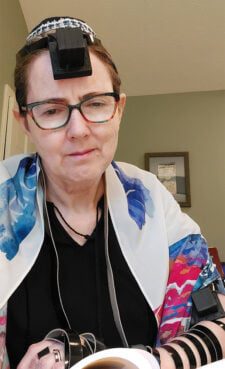(RNS) — After Amanda Siegel’s mother died in March, she decided she wanted to keep the tradition of saying the kaddish, the Jewish mourner’s prayer, every day for 11 months.The kaddish, as with most Jewish ritual prayer, requires a quorum of 10 adult Jews, known as a minyan.
There was only one problem.
Her synagogue in Indianapolis, where she lives, hasn’t resumed its daily minyan since the COVID-19 pandemic ended.
Like countless other Jews who got used to watching services online during the pandemic, Siegel tapped some keywords in Google to see what other synagogues were offering. She found two — one in Chicago and one in New York City — that offered minyans on the four days her own synagogue does not.
Each weekday for the past six months, therefore, Siegel powers up her laptop, wraps a prayer shawl over her shoulders (and often, a tefillin box, or or phylacteries over her head and arm) and recites the kaddish from her home in the company of other Jewish mourners hundreds of miles away.
Amanda Siegel wears a prayer shawl and tefillin during a Zoom minyan. Photo courtesy of Siegel
Pandemic practices have brought what appears to be fundamental changes to how many Americans practice their faith, and Jewish worship is no exception. A new survey by the Synagogue Studies Institute finds that 85% of Jewish synagogues in the U.S. now offer worship online — a marked jump from 24% that did in 2019, prior to the pandemic. More significantly, 70% of synagogues surveyed said they expect they will continue to do so five years from now.
The survey of 248 U.S. synagogues will be published this fall as part of Faith Communities Today, a multifaith research initiative that has been tracking trends in the U.S. religious landscape since 2000.
“Synagogues have embraced technology in a big way, which is interesting because if we look at 2010, synagogues lagged behind churches in using technology,” said Rabbi Aaron Spiegel, the study’s principal investigator.
As the latest study shows, the embrace of videoconferencing and livestreaming is actually helping Jews engage more fully with their faith.
“I like the Zoom minyan better than no minyan,” said Siegel. “There …
Article Attribution | Read More at Article Source
There was only one problem.
Her synagogue in Indianapolis, where she lives, hasn’t resumed its daily minyan since the COVID-19 pandemic ended.
Like countless other Jews who got used to watching services online during the pandemic, Siegel tapped some keywords in Google to see what other synagogues were offering. She found two — one in Chicago and one in New York City — that offered minyans on the four days her own synagogue does not.
Each weekday for the past six months, therefore, Siegel powers up her laptop, wraps a prayer shawl over her shoulders (and often, a tefillin box, or or phylacteries over her head and arm) and recites the kaddish from her home in the company of other Jewish mourners hundreds of miles away.
Amanda Siegel wears a prayer shawl and tefillin during a Zoom minyan. Photo courtesy of Siegel
Pandemic practices have brought what appears to be fundamental changes to how many Americans practice their faith, and Jewish worship is no exception. A new survey by the Synagogue Studies Institute finds that 85% of Jewish synagogues in the U.S. now offer worship online — a marked jump from 24% that did in 2019, prior to the pandemic. More significantly, 70% of synagogues surveyed said they expect they will continue to do so five years from now.
The survey of 248 U.S. synagogues will be published this fall as part of Faith Communities Today, a multifaith research initiative that has been tracking trends in the U.S. religious landscape since 2000.
“Synagogues have embraced technology in a big way, which is interesting because if we look at 2010, synagogues lagged behind churches in using technology,” said Rabbi Aaron Spiegel, the study’s principal investigator.
As the latest study shows, the embrace of videoconferencing and livestreaming is actually helping Jews engage more fully with their faith.
“I like the Zoom minyan better than no minyan,” said Siegel. “There …nnDiscussion:nn” ai_name=”RocketNews AI: ” start_sentence=”Can I tell you more about this article?” text_input_placeholder=”Type ‘Yes'”]

